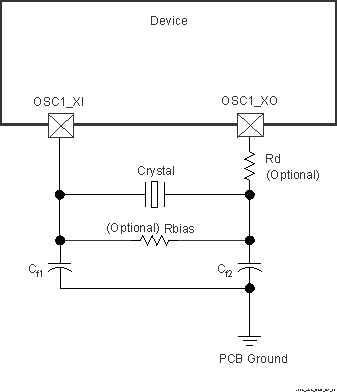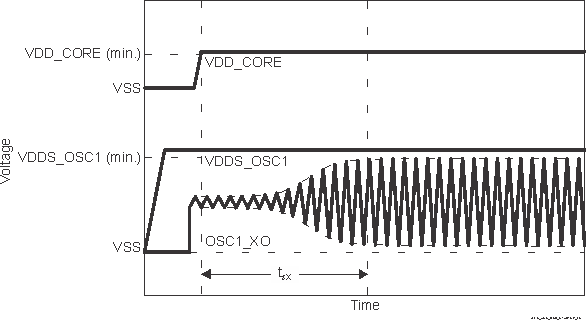ZHCSKP3K September 2021 – April 2024 TDA4VM , TDA4VM-Q1
PRODUCTION DATA
- 1
- 1 特性
- 2 应用
- 3 说明
- 4 Device Comparison
-
5 Terminal Configuration and Functions
- 5.1 Pin Diagram
- 5.2 Pin Attributes
- 5.3
Signal Descriptions
- 5.3.1 ADC
- 5.3.2 DDRSS
- 5.3.3 GPIO
- 5.3.4 I2C
- 5.3.5 I3C
- 5.3.6 MCAN
- 5.3.7 MCSPI
- 5.3.8 UART
- 5.3.9 MDIO
- 5.3.10 CPSW2G
- 5.3.11 CPSW9G
- 5.3.12 ECAP
- 5.3.13 EQEP
- 5.3.14 EHRPWM
- 5.3.15 USB
- 5.3.16 SERDES
- 5.3.17 OSPI
- 5.3.18 Hyperbus
- 5.3.19 GPMC
- 5.3.20 MMC
- 5.3.21 CPTS
- 5.3.22 UFS
- 5.3.23 PRU_ICSSG [Currently Not Supported]
- 5.3.24 MCASP
- 5.3.25 DSS
- 5.3.26 DP
- 5.3.27 Camera Streaming Interface Receiver (CSI_RX_IF) Subsystem
- 5.3.28 DSI_TX
- 5.3.29 VPFE
- 5.3.30 DMTIMER
- 5.3.31 Emulation and Debug
- 5.3.32 System and Miscellaneous
- 5.3.33 Power Supply
- 5.4 Pin Multiplexing
- 5.5 Pin Connectivity Requirements
-
6 Specifications
- 6.1 Absolute Maximum Ratings
- 6.2 ESD Ratings
- 6.3 Power-On-Hour (POH) Limits
- 6.4 Recommended Operating Conditions
- 6.5 Operating Performance Points
- 6.6 Electrical Characteristics
- 6.7 VPP Specifications for One-Time Programmable (OTP) eFuses
- 6.8 Thermal Resistance Characteristics
- 6.9
Timing and Switching Characteristics
- 6.9.1 Timing Parameters and Information
- 6.9.2
Power Supply Sequencing
- 6.9.2.1 Power Supply Slew Rate Requirement
- 6.9.2.2 Combined MCU and Main Domains Power-Up Sequencing
- 6.9.2.3 Combined MCU and Main Domains Power- Down Sequencing
- 6.9.2.4 Isolated MCU and Main Domains Power- Up Sequencing
- 6.9.2.5 Isolated MCU and Main Domains, Primary Power- Down Sequencing
- 6.9.2.6 Entry and Exit of MCU Only State
- 6.9.2.7 Entry and Exit of DDR Retention State
- 6.9.3 System Timing
- 6.9.4
Clock Specifications
- 6.9.4.1
Input and Output Clocks / Oscillators
- 6.9.4.1.1 WKUP_OSC0 Internal Oscillator Clock Source
- 6.9.4.1.2 WKUP_OSC0 LVCMOS Digital Clock Source
- 6.9.4.1.3 Auxiliary OSC1 Internal Oscillator Clock Source
- 6.9.4.1.4 Auxiliary OSC1 LVCMOS Digital Clock Source
- 6.9.4.1.5 Auxiliary OSC1 Not Used
- 6.9.4.1.6 WKUP_LFOSC0 Internal Oscillator Clock Source
- 6.9.4.1.7 WKUP_LFOSC0 Not Used
- 6.9.4.2 Output Clocks
- 6.9.4.3 PLLs
- 6.9.4.4 Module and Peripheral Clocks Frequencies
- 6.9.4.1
Input and Output Clocks / Oscillators
- 6.9.5
Peripherals
- 6.9.5.1 ATL
- 6.9.5.2 VPFE
- 6.9.5.3
CPSW2G
- 6.9.5.3.1 CPSW2G MDIO Interface Timings
- 6.9.5.3.2 CPSW2G RMII Timings
- 6.9.5.3.3
CPSW2G RGMII Timings
- 6.9.5.3.3.1 RGMII[x]_RXC Timing Requirements – RGMII Mode
- 6.9.5.3.3.2 CPSW2G Timing Requirements for RGMII[x]_RD[3:0], and RGMII[x]_RCTL – RGMII Mode
- 6.9.5.3.3.3 CPSW2G RGMII[x]_TXC Switching Characteristics – RGMII Mode
- 6.9.5.3.3.4 RGMII[x]_TD[3:0], and RGMII[x]_TX_CTL Switching Characteristics – RGMII Mode
- 6.9.5.4 CPSW9G
- 6.9.5.5 CSI-2
- 6.9.5.6 DDRSS
- 6.9.5.7 DSS
- 6.9.5.8 eCAP
- 6.9.5.9 EPWM
- 6.9.5.10 eQEP
- 6.9.5.11 GPIO
- 6.9.5.12 GPMC
- 6.9.5.13 HyperBus
- 6.9.5.14 I2C
- 6.9.5.15 I3C
- 6.9.5.16 MCAN
- 6.9.5.17 MCASP
- 6.9.5.18 MCSPI
- 6.9.5.19 MMCSD
- 6.9.5.20 CPTS
- 6.9.5.21 OSPI
- 6.9.5.22 PCIE
- 6.9.5.23 Timers
- 6.9.5.24 UART
- 6.9.5.25 USB
- 6.9.6 Emulation and Debug
-
7 Detailed Description
- 7.1 Overview
- 7.2 Processor Subsystems
- 7.3 Accelerators and Coprocessors
- 7.4
Other Subsystems
- 7.4.1 MSMC
- 7.4.2 NAVSS
- 7.4.3 PDMA Controller
- 7.4.4 Power Supply
- 7.4.5
Peripherals
- 7.4.5.1 ADC
- 7.4.5.2 ATL
- 7.4.5.3 CSI
- 7.4.5.4 CPSW2G
- 7.4.5.5 CPSW9G
- 7.4.5.6 DCC
- 7.4.5.7 DDRSS
- 7.4.5.8 DSS
- 7.4.5.9 VPFE
- 7.4.5.10 eCAP
- 7.4.5.11 EPWM
- 7.4.5.12 ELM
- 7.4.5.13 ESM
- 7.4.5.14 eQEP
- 7.4.5.15 GPIO
- 7.4.5.16 GPMC
- 7.4.5.17 Hyperbus
- 7.4.5.18 I2C
- 7.4.5.19 I3C
- 7.4.5.20 MCAN
- 7.4.5.21 MCASP
- 7.4.5.22 MCRC Controller
- 7.4.5.23 MCSPI
- 7.4.5.24 MMC/SD
- 7.4.5.25 OSPI
- 7.4.5.26 PCIE
- 7.4.5.27 SerDes
- 7.4.5.28 WWDT
- 7.4.5.29 Timers
- 7.4.5.30 UART
- 7.4.5.31 USB
- 7.4.5.32 UFS
-
8 Applications and
Implementation
- 8.1 Power Supply Mapping
- 8.2 Device Connection and Layout Fundamentals
- 8.3
Peripheral- and Interface-Specific Design Information
- 8.3.1 LPDDR4 Board Design and Layout Guidelines
- 8.3.2 OSPI and QSPI Board Design and Layout Guidelines
- 8.3.3 SERDES REFCLK Design Guidelines
- 8.3.4 USB VBUS Design Guidelines
- 8.3.5 System Power Supply Monitor Design Guidelines
- 8.3.6 High Speed Differential Signal Routing Guidance
- 8.3.7 Thermal Solution Guidance
- 9 Device and Documentation Support
- 10Revision History
- 11Mechanical, Packaging, and Orderable Information
6.9.4.1.3 Auxiliary OSC1 Internal Oscillator Clock Source
Figure 6-28 shows the recommended crystal circuit. All discrete components used to implement the oscillator circuit should be placed as close as possible to the OSC1_XI and OSC1_XO pins.
 Figure 6-28 OSC1 Crystal Implementation
Figure 6-28 OSC1 Crystal ImplementationThe crystal must be in the fundamental mode of operation and parallel resonant. Table 6-31 summarizes the required electrical constraints.
| PARAMETER | MIN | TYP | MAX | UNIT | |||
|---|---|---|---|---|---|---|---|
| Fxtal | Crystal Parallel Resonance Frequency | 19.2 | 27 | MHz | |||
| Fxtal | Crystal Frequency Stability and Tolerance | Ethernet RGMII and RMII not used | ±100 | ppm | |||
| Ethernet RGMII and RMII using derived clock | ±50 | ||||||
| CL1+PCBXI | Capacitance of CL1 + CPCBXI | 12 | 24 | pF | |||
| CL2+PCBXO | Capacitance of CL2 + CPCBXO | 12 | 24 | pF | |||
| CL | Crystal Load Capacitance | 6 | 12 | pF | |||
| Cshunt | Crystal Circuit Shunt Capacitance | ESRxtal = 30 Ω | 19.2 MHz, 20 MHz, 24 MHz, 25 MHz, 26 MHz, 27 MHz |
7 | pF | ||
| ESRxtal = 40 Ω | 19.2 MHz, 20 MHz, 24 MHz, 25 MHz, 26 MHz, 27 MHz |
5 | pF | ||||
| ESRxtal = 50 Ω | 19.2 MHz, 20 MHz, 24 MHz, 25 MHz, 26 MHz, 27 MHz |
5 | pF | ||||
| ESRxtal = 60 Ω | 19.2 MHz, 20 MHz, 24 MHz | 5 | pF | ||||
| ESRxtal = 80 Ω | 19.2 MHz, 20 MHz | 5 | pF | ||||
| 25 MHz | 3 | pF | |||||
| ESRxtal = 100 Ω | 19.2 MHz, 20 MHz | 3 | pF | ||||
| ESRxtal | Crystal Effective Series Resistance | 100 | Ω | ||||
When selecting a crystal, the system design must consider the temperature and aging characteristics of a based on the worst case environment and expected life expectancy of the system.
Table 6-32 details the switching characteristics of the oscillator and the requirements of the input clock.
| PARAMETER | MIN | TYP | MAX | UNIT | |
|---|---|---|---|---|---|
| CXI | XI Capacitance | 1.55 | pF | ||
| CXO | XO Capacitance | 1.35 | pF | ||
| CXIXO | XI to XO Mutual Capacitance | 0.9 | fF | ||
| ts | Maximum Start-up Time | 9.5(1) | ms | ||
 Figure 6-29 OSC1 Start-up Time
Figure 6-29 OSC1 Start-up Time